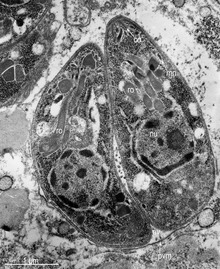Apicomplexan life cycle
[1] Each stage in the life cycle of an apicomplexan organism is typified by a cellular variety with a distinct morphology and biochemistry.Organisms whose life cycles rely on this process include Theileria, Babesia,[4] Plasmodium,[5] and Toxoplasma gondii.A trophozoite (G. trophē, nourishment + zōon, animal) is the activated, intracellular feeding stage in the apicomplexan life cycle.A hypnozoite (G. hypnos, sleep + zōon, animal) is a quiescent parasite stage that is best known for its "... probable association with latency and relapse in human malarial infections caused by Plasmodium ovale and P.[13] A bradyzoite (G. bradys, slow + zōon, animal) is a sessile, slow-growing form of zoonotic microorganisms such as Toxoplasma gondii, among others responsible for parasitic infections.In chronic (latent) toxoplasmosis, bradyzoites microscopically present as clusters enclosed by an irregular crescent-shaped wall (cysts) in infected muscle and brain tissues.[14] A tachyzoite (G. tachys, fast + zōon, animal), contrasting with a bradyzoite, is a form typified by rapid growth and replication.An oocyst (G. ōon, egg + kystis, bladder) is a hardy, thick-walled spore, able to survive for lengthy periods outside a host.


apicomplexanApicomplexansintracellular parasiteslife cyclemorphologybiochemistryFission (biology)multiple fissionschizogonyasexually reproductivenucleusorganellesCytokinesismultinucleatedTheileriaBabesiaPlasmodiumToxoplasma gondiikaryogamyzygotemeiosisasexual reproductionbuddingPlasmodium falciparumtransmission electron microscopyhepatocytesglidingmerogonycoccidiosisred blood cellsgametocytegametemicrogametesmacrogametemosquitoestrophozoitezoonoticmicroorganismstoxoplasmosiscoccidianspseudocystsToxoplasmaSarcocystisvacuolesEimeriaIsosporaCryptosporidiumgenomesamino acidsteroidmetabolicDNA repairproteomemutationTrematode life cycle stages